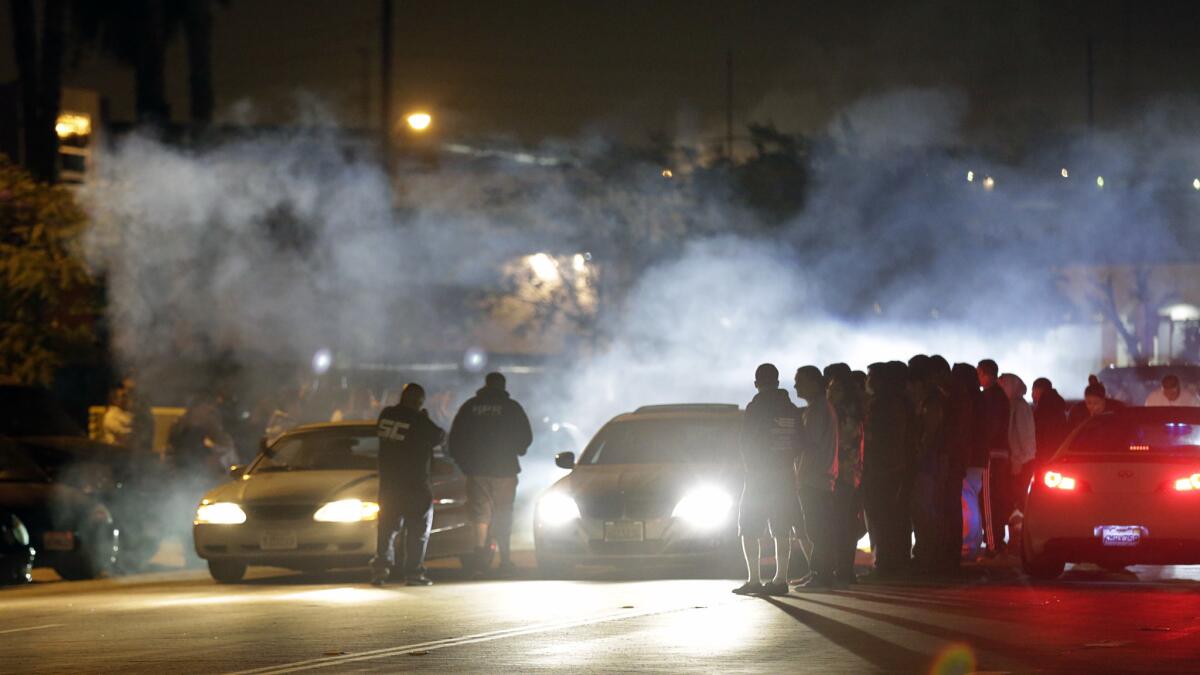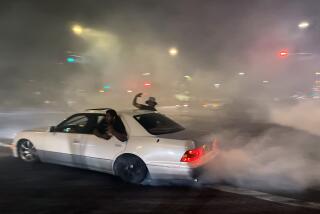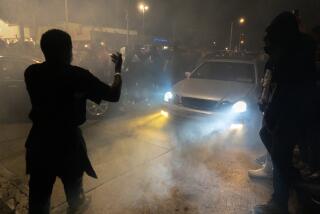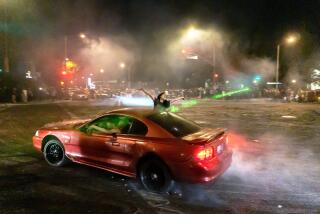Street racers are taking over California roads emptied by coronavirus

- Share via
For the past month, the novel coronavirus has turned normally bustling locales and highways across Los Angeles into yawning, vacant stretches that might be unsettling to some.
The usual mess of costumed characters and tourists dotting the Walk of Fame is nowhere to be found. The parking-lot-like stretch of the 405 Freeway that traps thousands on daily rush-hour commutes is flowing freely during the day.
But where some see emptiness, others see a speedway.
In recent weeks, police across California say street racers have been quick to turn the state’s cleared-out roadways into their own personal playgrounds. From Southern California to the Bay Area, racers have been challenging one another at dangerous speeds on surface streets or rushing intersections to perform burnouts and other dangerous vehicle stunts, investigators say.
The large gatherings — generally known as “sideshows” or “takeovers” — are especially troubling in the context of the coronavirus, police say. In some parts of the state, grocery stores aren’t letting more than 50 people inside at one time. At a takeover scene, authorities say hundreds of people might be in close proximity at one intersection, with barely anyone wearing masks or gloves.
“It’s 200 people gathered in an intersection, which is not that big of an area. No one is six feet apart,” said California Highway Patrol Officer Andrew Swank, who is part of the street racing task force in the agency’s Southern Division. “The probability of spreading the virus is pretty high if someone is a carrier.”
Street racing is inherently dangerous with or without the added risk of the coronavirus. A Los Angeles Times investigation found 179 people had died in speed contests in Los Angeles County from 2000 to 2017, and investigators have said street racing incidents have become an increasing concern in recent years.
The empty blacktops are drawing in a variety of car enthusiasts, officials say. CHP Officer Ryann Grimes said groups that engage in “roll racing” — referring to packs of cars driving along a freeway before rocketing off chasing their car’s top speed — have been more prevalent as the bulk of Californians have taken sheltering at home seriously.
In Sacramento, police and sheriff’s officials said they had to deal with several sideshows that drew groups of 100 or more to various locations around the county on Easter Sunday. In late March, Oakland Police said they made three arrests and towed at least a dozen vehicles after interrupting a sideshow.
The head-to-head drag races most commonly associated with street racing in pop culture have been occurring more frequently in the San Fernando Valley in Los Angeles, according to investigators, who say the random nature of those contests is especially dangerous to pedestrians, no matter how few are out these days. LAPD Asst. Chief Robert Arcos, who oversees patrol operations, said he believes officers have been able to force most takeovers off city streets and onto the freeways.
But one law enforcement official, who spoke on condition of anonymity in order to discuss the matter candidly, said Los Angeles-area racers have grown increasingly brazen since the pandemic paralyzed the city. The younger crews that organize takeovers have begun trying to stage gatherings in popular intersections, including near the Staples Center in downtown L.A., which would have been impossible just a few weeks ago.
“Activity is actually picking up. They’re taking advantage … they’re under the assumption that law enforcement is busy with the whole pandemic situation, that we’re too busy to deal with them,” the official said.
The most brazen street racing incident in recent weeks, however, may have happened about 1,100 miles north on the 405, when about two dozen cars blocked off a section of the Fremont Bridge in Portland, Ore., and performed burnouts, according to a statement issued by the Portland Police Bureau.
Donald Galaz, a member of the International Brotherhood of Street Racers, hasn’t personally hit the roads since the state advised residents to stay home. But he’s not surprised to see a group as passionate as the car community capitalizing on the situation.
Friends of his who have been organizing drag races have taken some precautions by wearing masks and gloves and trying to keep crowds small. But as racing groups often organize on social media platforms, it’s hard to limit who shows up.
“Once the word gets out … people flock to those locations,” Galaz said. “That’s their love and that’s their passion.”
Galaz cautioned police against blaming any recent uptick in high-speed activity solely on the street racing community, noting that he’s seen everyday drivers pushing the throttle toward the triple-digits in the middle of the day on empty roads as well. Earlier this month, the city Department of Transportation released a study showing speeds are up by as much as 30% on some Los Angeles surface streets.
As city and state officials have become more stringent about enforcing social distancing in recent weeks, some police agencies have begun applying those violations to street racers.
In Sacramento, where sideshows earlier this month led to at least one crash involving a law enforcement vehicle, Police Chief Daniel Hahn said his officers would begin citing those detained at racing scenes for violating the county’s health order. Swank and Grimes, the CHP task force members, said the agency is taking similar measures across the state.
Combined with the issuance of a ticket for being a spectator at a speed contest, some investigators hope the financial hit might be enough to deter some people from racing scenes.
The same open streets that have drawn racers out are also making enforcement harder, some investigators said.
Police often struggle to corral drivers and spectators at large takeover scenes because they’re severely outmanned — typically a handful of police cruisers will be tasked with breaking up a sideshow involving as many as 300 people. Now, with nothing but air between the racers and their next destination, Grimes said arrests are becoming more challenging and dangerous.
“We’re more noticeable getting there because the streets are empty. When we get there the streets are still empty so it’s easier for them to flee … and they’re going fast on the freeway to get to their second location,” he said. “They’re just being incredibly reckless with the situation that they’re given.”
More to Read
Sign up for Essential California
The most important California stories and recommendations in your inbox every morning.
You may occasionally receive promotional content from the Los Angeles Times.












